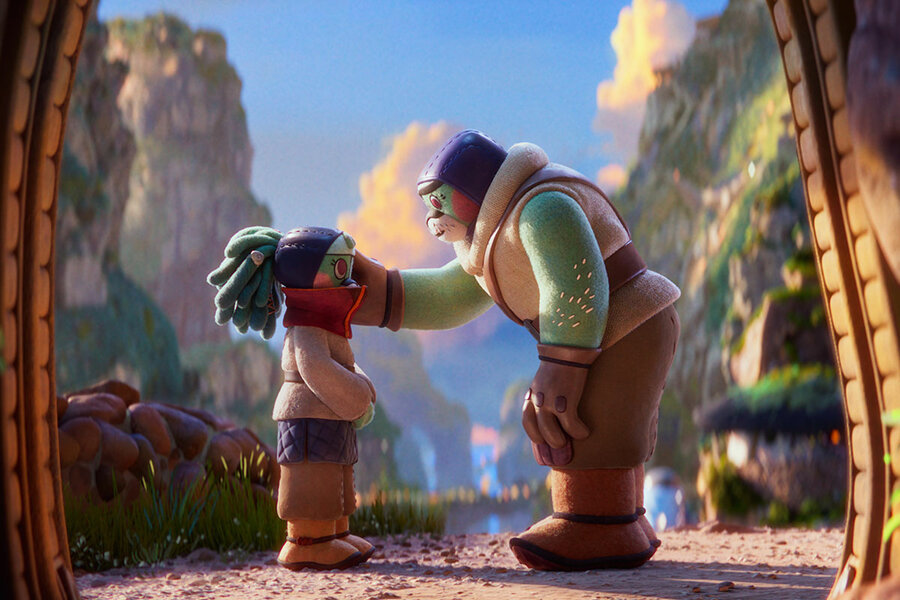From a galaxy far, far away to Cape Town: Star Wars re-imagined
Loading...
| JOHANNESBURG
When George Lucas first created the “Star Wars” universe nearly five decades ago, he probably didn’t imagine extraterrestrial worlds crawling with fynbos, the brightly colored, prickly shrub land of South Africa’s Western Cape. Nor did he likely envision his Jedi warriors channeling the energy of sangomas, southern African traditional healers.
But when South African filmmakers Nadia Darries and Daniel Clarke were asked recently to create their own version of the “Star Wars” universe for an animated short film, their alien world bore distinct imprints of their Earthly homeland.
“We weren’t super intentional about it, but of course we are South Africans, so we are drawing on real experiences from our own world,” says Ms. Darries, an animator from Cape Town whose work has appeared on the BBC.
Why We Wrote This
A story focused onFor decades, “Star Wars” has brought joy to fans across Africa. But only now, as animators around the world re-imagine the franchise through their own lens, are the continent’s diverse cultures finding their place in the galaxy.
The pair’s 15-minute film, “Aau’s Song,” is part of a recently released anthology called “Star Wars: Visions,” in which animation studios from around the world were invited to re-imagine the famous fantasy universe through their own eyes. The resulting shorts feature Jedi in saris, anime-inspired Sith lords, and lightsaber-wielding teenagers with thick Irish brogues.
“The ‘Star Wars’ universe is an incredible sandbox,” says Mr. Clarke, whose film with Ms. Darries was the only African film in the anthology.
Since its inception, “Star Wars” has been the world’s darling. And its films have long had a dedicated following across the African continent. In 2015, for instance, “The Force Awakens” had the single most profitable opening day in South African cinema history to that point. And the Earthside location of Darth Vader’s twin-mooned home planet, Tatooine, is in Tunisia, where it’s been a popular site of pilgrimage for both local and international fans.
But the franchise itself has often been slow to reflect back the diversity of its audience. The first “Star Wars” film, the 1977 “A New Hope,” had no characters of color in speaking roles, and only 6.3% of its dialogue was spoken by women.
“As someone growing up in South Africa, my perception of sci-fi and fantasy was that the central character will have pale skin, speak English, and probably be a man,” says Omar Morto, a South African radio presenter, musician, and lifelong “Star Wars” fan.
In recent years, however, “Star Wars” has made strides to look more representative of planet Earth, featuring protagonists of color and female characters who actually speak – sometimes even to each other. But its universe is still being imagined, largely, by Westerners.
Two years ago, Lucasfilm, the “Star Wars” production house, released a series of short, “Star Wars”-inspired films made by Japanese anime studios called “Star Wars: Visions.” The reaction to that series was so positive, producers said, that they decided to create a second volume, this time featuring animators from around the world. The idea was to “open ... up bold new ways of seeing what a Star Wars story can be,” said James Waugh, the program’s executive producer, in promotional materials.
But for Ms. Darries and Mr. Clarke, who made “Aau’s Song” with the South African studio Triggerfish, the project never felt quite so cosmic. They simply wanted to tell a story that meant something to them, Mr. Clarke says.
“Aau’s Song” takes place on a planet called Korba. Its inhabitants mine the kyber crystals used in lightsabers, which have been corrupted by the Sith of the Dark Side. Enter Aau, a young girl who has a magical singing voice that can alter the crystals – and a protective father afraid she’ll put herself in danger if she uses it.
In that way, she is not unlike Ms. Darries, who grew up “sneaking out to sing in rock bands underage at bars, with my father mostly unaware,” she recalls. For her, when imagining a new Star Wars universe, “singing felt like a natural way for someone to connect to the force.”
It also felt natural, she says, that the story’s wise woman – a visiting Jedi named Kratu – would resemble a kind of wise woman found in her own family, a sangoma, or diviner. Like Jedi, who often act as peacekeepers and have the power to connect to people’s thoughts, sangomas heal personal and social rifts in part via their connections with the ancestral world.
And though the story is about a girl with the power to purify lightsaber crystals, Mr. Clarke says they saw it as fundamentally being “about a character healing a poisoned land, which is a very South African story.”
Mr. Morto, the radio presenter, says he can still remember the rainy Cape Town afternoon in the 1990s when his uncle came back from the video rental store with “Return of the Jedi.” From the moment “In a galaxy far, far away” rolled across the screen, he was transfixed. “Since then, it has been my life,” he says.
And so, seeing a Star Wars universe that looked like South Africa in “Aau’s Song” “was special to experience,” he says. “It’s very gratifying to see a piece of sci-fi that’s informed by Africa.”







